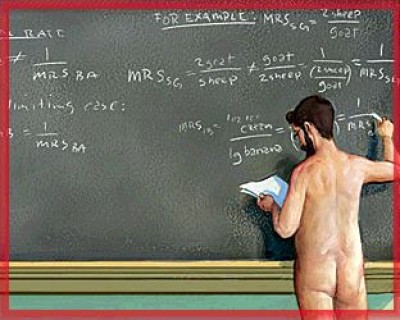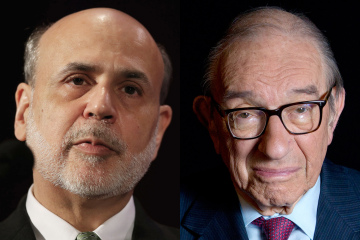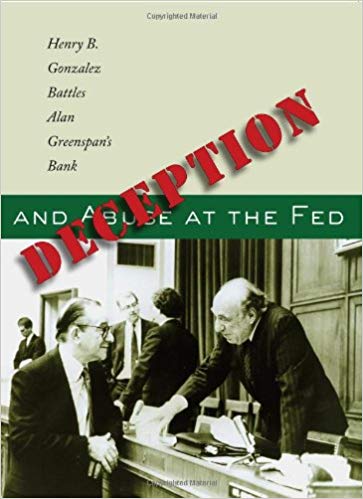How Banksters Control the Professions
February 28, 2019

(left, The professor has no clothes)
The Fed is owned by a syndicate of mostly foreign-based Jewish Masons.
They create the medium of exchange ("currency" "credit") in the form of a debt to themselves, something our government could do debt-and-interest-free. This exceptional 2009 article reveals why economists don't blow the whistle on this mind-boggling scam.
The template described below is duplicated in all the professions: The American Historical Association, American Medical Association, American Psychological Association, The American Bar Association. All are funded and controlled by the central bankers. It's a wonder this article was posted at Huffington Post and is still up.
Back in the 1960's, we used to say the older generation had sold their souls to the devil. Little did we expect that this was literally true and that we would do the same thing.
by Ryan Grim
(excerpt by henrymakow.com)
The Federal Reserve, through its extensive network of consultants, visiting scholars, alumni and staff economists, so thoroughly dominates the field of economics that real criticism of the central bank has become a career liability for members of the profession, an investigation by the Huffington Post has found.
This dominance helps explain how, even after the Fed failed to foresee the greatest economic collapse since the Great Depression, the central bank has largely escaped criticism from academic economists. In the Fed's thrall, the economists missed it, too.
"The Fed has a lock on the economics world," says Joshua Rosner, a Wall Street analyst who correctly called the meltdown. "There is no room for other views, which I guess is why economists got it so wrong."
One critical way the Fed exerts control on academic economists is through its relationships with the field's gatekeepers. For instance, at the Journal of Monetary Economics, a must-publish venue for rising economists, more than half of the editorial board members are currently on the Fed payroll -- and the rest have been in the past.

The Fed failed to see the housing bubble as it happened, insisting that the rise in housing prices was normal. In 2004, after "flipping" had become a term cops and janitors were using to describe the way to get rich in real estate, then-Federal Reserve Chairman Alan Greenspan said that "a national severe price distortion [is] most unlikely." A year later, current Chairman Ben Bernanke said that the boom "largely reflect strong economic fundamentals."
The Fed also failed to sufficiently regulate major financial institutions, with Greenspan -- and the dominant economists -- believing that the banks would regulate themselves in their own self-interest.
Despite all this, Bernanke was nominated for a second term by President Obama.
In the field of economics, the chairman remains a much-heralded figure, lauded for reaction to a crisis generated, in the first place, by the Fed itself. Congress is even considering legislation to greatly expand the powers of the Fed to systemically regulate the financial industry.
Paul Krugman, in Sunday's New York Times magazine, did his own autopsy of economics, asking "How Did Economists Get It So Wrong?" Krugman concludes that "[e]conomics, as a field, got in trouble because economists were seduced by the vision of a perfect, frictionless market system."
So who seduced them? The Fed did it.
THREE DECADES OF DOMINATION
The Fed has been dominating the profession for about three decades. "For the economics profession that came out of the [second world] war, the Federal Reserve was not a very important place as far as they were concerned, and their views on monetary policy were not framed by a working relationship with the Federal Reserve. So I would date it to maybe the mid-1970s," says University of Texas economics professor -- and Fed critic -- James Galbraith.
"The generation that I grew up under, which included both Milton Friedman on the right and Jim Tobin on the left, were independent of the Fed. They sent students to the Fed and they influenced the Fed, but there wasn't a culture of consulting, and it wasn't the same vast network of professional economists working there."
But by 1993, when former Fed Chairman Greenspan provided the House banking committee with a breakdown of the number of economists on contract or employed by the Fed, he reported that 189 worked for the board itself and another 171 for the various regional banks. Adding in statisticians, support staff and "officers" -- who are generally also economists -- the total number came to 730. And then there were the contracts. Over a three-year period ending in October 1994, the Fed awarded 305 contracts to 209 professors worth a total of $3 million.
HOW DOMINANT IS THE FED TODAY?
The Federal Reserve's Board of Governors employs 220 PhD economists and a host of researchers and support staff, according to a Fed spokeswoman. The 12 regional banks employ scores more. (HuffPost placed calls to them but was unable to get exact numbers.) The Fed also doles out millions of dollars in contracts to economists for consulting assignments, papers, presentations, workshops, and that plum gig known as a "visiting scholarship."
A Fed spokeswoman says that exact figures for the number of economists contracted with weren't available. But, she says, the Federal Reserve spent $389.2 million in 2008 on "monetary and economic policy," money spent on analysis, research, data gathering, and studies on market structure; $433 million is budgeted for 2009.
That's a lot of money for a relatively small number of economists. According to the American Economic Association, a total of only 487 economists list "monetary policy, central banking, and the supply of money and credit," as either their primary or secondary specialty; 310 list "money and interest rates"; and 244 list "macroeconomic policy formation [and] aspects of public finance and general policy." The National Association of Business Economists tells HuffPost that 611 of its roughly 2,400 members are part of their "Financial Roundtable," the closest way they can approximate a focus on monetary policy and central banking.

Robert Auerbach, a former investigator with the House banking committee, spent years looking into the workings of the Fed and published much of what he found in the 2008 book, "Deception and Abuse at the Fed". A chapter in that book, excerpted here, provided the impetus for this investigation.
Auerbach found that in 1992, roughly 968 members of the AEA designated "domestic monetary and financial theory and institutions" as their primary field, and 717 designated it as their secondary field. Combining his numbers with the current ones from the AEA and NABE, it's fair to conclude that there are something like 1,000 to 1,500 monetary economists working across the country. Add up the 220 economist jobs at the Board of Governors along with regional bank hires and contracted economists, and the Fed employs or contracts with easily 500 economists at any given time. Add in those who have previously worked for the Fed -- or who hope to one day soon -- and you've accounted for a very significant majority of the field.
Auerbach concludes that the "problems associated with the Fed's employing or contracting with large numbers of economists" arise "when these economists testify as witnesses at legislative hearings or as experts at judicial proceedings, and when they publish their research and views on Fed policies, including in Fed publications."
GATEKEEPERS ON THE PAYROLL
The Fed keeps many of the influential editors of prominent academic journals on its payroll. It is common for a journal editor to review submissions dealing with Fed policy while also taking the bank's money. A HuffPost review of seven top journals found that 84 of the 190 editorial board members were affiliated with the Federal Reserve in one way or another.
"Try to publish an article critical of the Fed with an editor who works for the Fed," says Galbraith. And the journals, in turn, determine which economists get tenure and what ideas are considered respectable.
The pharmaceutical industry has similarly worked to control key medical journals, but that involves several companies. In the field of economics, it's just the Fed.
Being on the Fed payroll isn't just about the money, either. A relationship with the Fed carries prestige; invitations to Fed conferences and offers of visiting scholarships with the bank signal a rising star or an economist who has arrived.
Affiliations with the Fed have become the oxygen of academic life for monetary economists. "It's very important if you are tenure track and don't have tenure, to show that you are valued by the Federal Reserve," says Jane D'Arista, a Fed critic and an economist with the Political Economy Research Institute at the University of Massachusetts, Amherst.
----------------
Related - America's Secret Establishment: An Introduction to the Order of Skull & Bones By Antony C. Sutton







Pedro said (February 28, 2019):
Previous generations might have sold their soul to the devil, subsequent generations have given it away.
"American Historical Association, American Medical Association , American Psychological Association, The American Bar Association. "
What do these all have in common? They can all be abbreviated to AA, which means Arseholes Anonymous.
Economists - know the price of everything, the value of nothing, and the supremacy of secrecy. Wonder why?